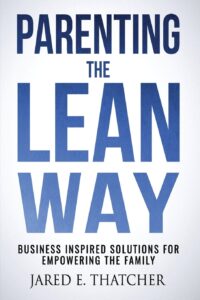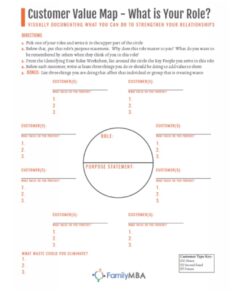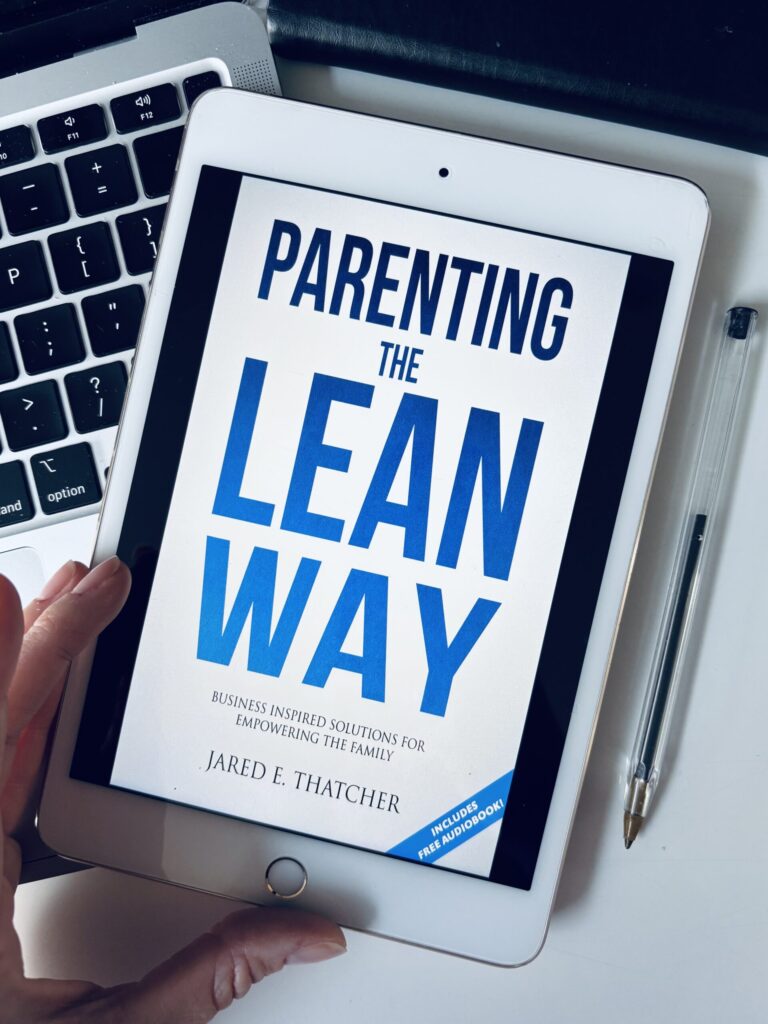 Parenting The Lean Way
Parenting The Lean Way
Business Inspired Solutions for Empowering the Family
Jared E. Thatcher
Thatcher & Company, LLC; 1st edition (26 Jan. 2018)
About Jared Thatcher
Jared E. Thatcher is the world’s leading expert on Lean Parenting™, his advice and business parenting tools are used by parents in over 130 countries. He has lectured all over the world and speaks three languages. He is a management consultant working with international charities, fortune 500 companies, government agencies, and small businesses, helping them solve problems, analyze data, and implement Lean into their organizations. He earned his MBA in International Business from the University of Edinburgh in Scotland, which included study at EADA Business School in Barcelona, Spain. He has his Lean Bronze Certification (LBC) from the Society of Manufacturing Engineers, is a Certified Scrum Master (CSM), and has his Project Management Professional (PMP) certification. An eighth generation Oregonian, Jared lives outside of Portland, Oregon with his wife and four children.
About The Book
“Parenting the Lean Way increases the tools we have available in our parenting tool box by using the business philosophy of Lean. In business or parenting, Lean can make life easier. In its simplest form, Lean changes your focus from you to those you serve. Lean looks for ways to increase the value of what you do for others, while eliminating or reducing those things that are not adding value. Continuous improvement is at the heart of Lean. It can help you manage your time, improve your ability to communicate, solve problems, resolve conflicts, and exhibit leadership. The Lean Way can be used by parents to improve family life.”
I first came across the idea of using business tools in family life in Bruce Feiler’s book The Secrets of Happy Families. He dedicates a couple of chapters to crafting a family mission statement and implementing Agile strategies—like family meetings and checklists—at home. (His TED Talk, Agile Programming – For Your Family, is a must-watch.) Since then, we’ve put these tools to work in our own home, and I have to admit—they’ve made parenting easier and a lot more enjoyable.
That got me thinking: What other business strategies could make family life better? My search led me to this little book, which I devoured in a weekend. And I have to say—I absolutely loved it. As someone with a background in management consulting and project management, I found it both insightful and very practical.
Jared draws from his business experience to show how high-impact business tools can improve family life—enhancing communication, leadership, problem-solving, and all those soft skills essential for running a household effectively. At the core of his approach is Lean Methodology, built on four key principles: valuing individuals, maximizing value, eliminating waste, and continuous improvement. In other words, it’s a productivity mindset for parenting. And trust me, these Lean tools can make your parenting journey not just easier, but also more intentional.
If you’re a parent searching for a better way, this book is full of great ideas. My only gripe? Jared’s website is down, so you won’t be able to download the templates—and they’re really good.
Ok, let’s have a look at my favorite ideas.
Key Insights
Lean Philosophy And It’s Core Principles
“What exactly is Lean? It is a business concept from the manufacturing world that mandates that your focus should always be on your customer’s needs (the value and quality they expect). Most of the tools of Lean are thus focused on the continuous improvement of work processes. They systematically increase the quality and value you provide to your customer, while eliminating what doesn’t provide the customer with any value. This non-value-added work we refer to as waste. Lean then is a methodology of continuous improvement to add value for the customer, while reducing or eliminating waste from the system.”
Jared kicks off the book by breaking down the Lean philosophy, and I couldn’t agree more with him—this mindset works in family life. Instead of chasing perfection—perfect parents, perfect kids, perfect schedules—Lean teaches us something far more sustainable: focus on progress, not perfection. When we shift our mindset to adding value and reducing waste, decision-making becomes clearer, family life flows more smoothly, and we create an environment where everyone grows together.
It reminded me of Danish psychologist Jesper Juul’s wisdom from The Art of Saying No with a Clear Conscience:
“Life within the family is not about who wins. It is about ensuring that everyone gets as much as possible of what they need, and as little as possible of what might hurt them.”
Before we dive into specific tools, let’s look at the four Lean principles that Jared distills into one simple sentence:
“Empower people to improve value and eliminate waste so you can achieve continuous improvement.”
Let’s break it down:
Principle 1: Valuing the Individual
People are the heart of any system, whether it’s a Fortune 500 company or a family. In Lean, this means recognizing that every person—child or adult—has unique strengths, perspectives, and needs. Truly valuing your kids isn’t just about loving them; it’s about empowering them. It’s giving them the tools to make better decisions, supporting them as they develop new skills, and helping them build real competence in their areas of responsibility.
Principle 2: Maximizing Value
Lean thinking asks: What truly matters? In business, it’s about delivering the highest value to customers. In parenting, it’s about shifting perspective—seeing your family as the people you serve and asking, How can I support them in the best way possible? That’s the core of servant leadership: “Thinking with purpose and long-term vision, so that when you interact with others, you are thinking about what will provide them with the best experience.” A great tool for this is the Customer Value Map (more on that later), which helps you clarify what matters most to your kids and spouse—so you can focus on that instead of sweating the small stuff.
Principle 3: Eliminating Waste
“Keep doing what works, stop doing what doesn’t, and look for ways to get a little better every day.”
In business, waste is anything that drains time, energy, or resources without adding real value. It’s the inefficiencies, redundancies, and distractions that slow progress. In family life, waste takes many forms—unnecessary power struggles, constant nagging, overcommitted schedules, or even emotional baggage that weighs us down. Eliminating waste at home isn’t just about streamlining household management (though that helps). It’s also about improving ourselves as individuals – being intentional with our energy, focusing on what truly matters, and letting go of habits, routines, or mindsets that create stress instead of connection. When we remove the unnecessary, we create space for what actually adds value—stronger relationships, personal growth, and a more peaceful home environment.
Principle 4: Continuous Improvement
At the core of Lean is Kaizen—the idea that small, consistent improvements lead to big results. Parenting is an ongoing process, not a one-time success or failure. Every challenge is an opportunity to tweak, adjust, and improve. This is where a growth mindset transforms family life: mistakes aren’t setbacks, they’re lessons. The moment you embrace continuous improvement, you stop chasing perfection and start becoming an improvenist—someone who is always evolving, learning, and adapting.
These principles aren’t just great for business—they’re a rock-solid foundation for parenting. Now, let’s take a closer look at one of them in action.
Increase Focus By Adding Value
“As parents, we need to employ this business concept of Maximizing Value into our lives. Creating value is as much a business tool as it is a philosophy of life. What does this mean? It means that instead of just going through the motions of being a parent, a spouse, a sibling, a friend, a colleague or a boss, we should actively be thinking of what value we are adding to those we associate with. We should seek to understand from their perspective what they want from us.”
This has become a guiding principle in my own life—Maximizing Value. What do your kids truly need from you? What does your spouse need in your relationship? How can you support their growth, their happiness, their confidence? How can you add as much value as possible to the people who matter most?
This shift in mindset is powerful. Instead of being driven by ego, autopilot, or expectations, you start serving those you love with intention. And as Jared explains, the rewards are profound:
“By sacrificing a little of what we want, we receive far more than we give up. You create memories that your family will treasure forever. Your relationships deepen, communication increases, and you are proactive in your parenting. Our focus should always be on increasing the value we add to others, especially our family members.”
When you approach parenting through the lens of adding value, decision-making becomes clearer. Do you spend the weekend passively watching movies or take your kids on an adventure they’ll never forget? Do you punish for “bad behavior,” or use positive discipline to teach a meaningful lesson? Do you order pizza, or cook together and create a memory in the process?
Yes, it takes effort. But when you have a strong why—adding value—parenting starts to feel less like a series of chores and more like a meaningful mission.
Now, let’s move to practice – in the book Jared shares a great exercise that will help you get clear on how you can add value to your family. He calls it The Customer Value Map.
The Customer Value Map
“The “Customer Value Map,” is a simple exercise or tool that will allow you to gain a better insight into those you are serving in each of your roles.”
If you decide to implement just one tool from this book, make it this one. The Customer Value Map is a simple yet powerful exercise that gives you deep insight into the people you serve in each of your roles. It will help you gain clarity on your impact as a parent and create a clear vision for how to change your own behaviour to add more value to family life.
In the book, Jared provides a fantastic template for this exercise. Unfortunately, since his website is down, there’s no option to download it—but here’s a screenshot for reference:

Here is what to do:
- Define Your Role
- Write down one of your key roles (e.g., parent, spouse, mentor) at the top of the center circle.
- Clarify Your Purpose and Write Your Mission Statement
- Take a moment to reflect on the purpose of that role.
- Ask yourself: What would I most like to be remembered for in this role?
- Use action words (verbs) to create an inspiring and motivating mission statement for this role.
- Identify Your “Customers”
- List the people who benefit from your role.
- As a parent, your primary “customers” are your children—but who else?
- Your spouse (co-parenting impacts both of you).
- Your children’s future spouse and kids (how you parent now influences future generations).
- Your community (teachers, extended family, friends who interact with your child).
- Determine How You Add Value
- Write down the ways you currently provide value to these “customers.”
- Consider how you can increase the value you bring.
- Identify and Eliminate Waste
- Make a list of non-value-added activities that drain energy without benefiting your family. Examples include:
- Nagging instead of guiding.
- Using screen time as a substitute for real connection and play time.
- Doing things for your kids that they could do for themselves (robbing them of growth opportunities).
Now, grab a piece of paper and think of your very own Customer Value Map!
P.S.: If this idea resonates with you, check out my article on Parenting With The End In Mind. It’s a powerful exercise that ties right into this idea!
The Family Board
“The Family Board is a much more in-depth tool than a simple Kanban Board, but it’s not complicated. The Family Board is adaptable to fit your family’s needs. There are just a few more elements than the Kanban Board’s “To Do,” “Doing,” and “Done.” The Family Board Meeting is the engine that runs Parenting the Lean Way. “
A Family Board is more than just a task tracker—it’s a system for running your household efficiently, improving communication, and helping your kids take more responsibility. Think of it as your Family Command Center.
While a Kanban Board (“To Do,” “Doing,” “Done”) is a great start, a high-functioning family system needs a few more key elements on their Family Board:
- Your Family Values – Your values define how your family operates. If you don’t have a Family Values statement yet, start here. Need guidance? The 7 Habits of Highly Effective Families by Stephen Covey, The Secrets of Happy Families by Bruce Feiler, and Dare to Lead by Brené Brown all offer great insights. You can also check out my articles How to Identify Your Core Values and Create a Value Statement & How to Write a Family Manifesto.
- A Recognition Section – People thrive on positive reinforcement. Use this section to highlight good decisions, kind actions, and moments when family members live out your values. Recognition builds motivation and strengthens habits.
- An Opportunity Section – Every system can be improved. This section is for identifying challenges and brainstorming solutions. What’s not working? How can we do better? Small tweaks lead to big changes over time.
- A Goal Section – Goals give your family a direction. Keep them SMART: Specific, Measurable, Achievable, Relevant, and Time-Bound. Track your progress and adjust as needed.
We also use our Family Board for morning checklists and are considering adding an afternoon checklist as well.
A system is only as strong as its engagement. To make the Family Board work, schedule regular Family Meetings. Jared outlines a great approach in the book, but if you want to see how we run ours, check out my article How Agile Family Meetings Help Us Be a Better Family.
Now it’s your turn – set up your very own Family Board and have your first Family Meeting!
The GATES Framework
“In the business world, practitioners of Lean often use a framework developed by the father of quality management, W. Edwards Deming, known as the PDSA cycle (Plan, Do, Study, Act). The PDSA cycle is used to make improvements and solve problems. You simply plan how you are going to fix a problem; you do the corrective actions; study the results of your solution on the problem; and act on any adjustments that need to be made. Then you repeat the cycle until the you have reached your improvement goals. […]
The GATES™ framework is a problem-solving methodology. This five-phase framework stands for: Gather, Ask, Tinker, Experiment, and Sustain. Each phase is designed to guide you through successfully analyzing and solving your problems and issues.”
GATES™ framework is a five-phase problem-solving method designed by Jared to help you create real, lasting change in your family. Think of it as Lean principles made practical for everyday parenting. Here’s how it works:
-
Gather
Before you can fix a problem, you need to understand it. This phase has two key steps:
- Identify what you want to improve in your family.
- Gather basic information about the issue so you can see what’s really driving it. To do this effectively, you need clarity on your Family Values—what matters most to you? That will help you prioritize and set meaningful goals.
Tools: Family Values & Family Coat of Arms, Family Focus Group, The Future State Solutions.
-
Ask
Once you’ve pinpointed the issue, start asking the right questions. The goal is to dig deep, uncover root causes, and brainstorm possible solutions.
Tools: The Power of Why, 5 Whys, The Personal Experience Wheel, Customer Value Maps, Voice of the Customer Interviews.
-
Tinker
This is where you get creative. Explore different solutions, prioritize your best ideas, and figure out how to measure progress. No more vague “let’s be better parents” resolutions—get specific.
Tools: The Family Board, Mini Sprint, Mini Sprint Retrospective Meetings.
-
Experiment
Now, test your plan. Implement your best solution and track what works (and what doesn’t). This is where theory meets reality.
Tools: Key Performance Indicators (KPIs).
-
Sustain
If something works, make it stick. This phase is all about turning improvements into habits so they don’t disappear the moment life gets busy.
Tools: Definition of Done, Standard Work Instruction, Retrospectives, Family One-on-Ones, Generating Insights, Focus On / Focus Off.
This framework isn’t just a nice idea—it’s a practical, repeatable process to help you build the family life you actually want. If you’re serious about making change, check out the book for all the tools and worksheets. I personally found them super useful!
Action Steps For You
- Create Your Customer Value Map: Take 20 minutes to map out your role as a parent using the Customer Value Map. Define your purpose, identify your “customers” (children, spouse, community), list how you currently add value, and pinpoint areas where you can eliminate “waste” (nagging, over-scheduling, doing things for kids instead of teaching them). This will help clarify your priorities and focus on what truly benefits your family.
- Set Up a Family Board: Implement a Family Board with sections for tasks (Kanban-style), family values, recognition, opportunities, and goals. Use it to improve communication, encourage responsibility, and track progress. Hold a weekly family meeting to keep everyone engaged and involved in continuous improvement.
- Apply the GATES Framework to a Parenting Challenge: Identify one recurring parenting challenge (e.g., morning routines, homework struggles, sibling conflicts) and use the GATES framework to tackle it.
Quotes From The Book
“We need to be flexible and agile in how we parent. We need to be able to quickly adjust our parenting techniques and customize our approach to best help each child based on their individual needs.”
“When we are concentrating on helping others, we spend less time thinking about ourselves and our problems, and more time adding value. This helps us feel more fulfilled. This is one of the secrets to happiness.”
“In the family we want to shape our rules to be positive, uplifting, and detail what to do, rather than what not to do: keep it simple and keep it safe; we allow others to finish their thoughts; we listen; we share ideas; we speak in a pleasant manner; we are kind when we speak.”
“Establishing clear values early in our children’s development is important in order to fortify them against the competing values that your family may not agree with.”
“Can you imagine the impact you will have in your roles when you act with purpose? When your actions are focused on providing greater value? When those you are serving in each of your roles feel like you are going out of your way to do things just for them? There is power in thinking in terms of what the “customer” wants. There is power in providing value and eliminating waste. This is Parenting the Lean Way.”
“No one at the end of their life says, “I wish I had spent more time at the office.” Rather they remember good memories [value] (the family vacations, the time you spent working together in the garden), and unfortunately, they also remember the bad memories [waste] (the unkind words, the fights, and every time you were perceived as unfair).”



